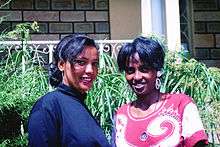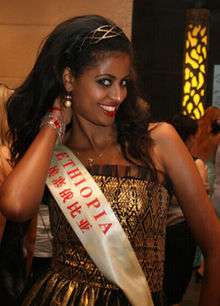Women in Ethiopia
| |||||||||||||
| Gender Inequality Index | |||||||||||||
|---|---|---|---|---|---|---|---|---|---|---|---|---|---|
| Value | NR | ||||||||||||
| Rank | NR | ||||||||||||
| Maternal mortality (per 100,000) | 350 (2010) | ||||||||||||
| Women in parliament | 25.5% (2012) | ||||||||||||
| Females over 25 with secondary education | NA | ||||||||||||
| Women in labour force | 78.4% (2011) | ||||||||||||
| Global Gender Gap Index[1] | |||||||||||||
| Value | 0.6198 (2013) | ||||||||||||
| Rank | 118th out of 144 | ||||||||||||
There have been several studies concerning women in Ethiopia. Historically, elite women in Ethiopia have been visible as administrators and warriors. This never translated into any benefit to improve the rights of women, but it had meant that women could inherit and own property, and act as advisors on important communal matters. As late as the first part of the nineteenth century, Queen Menen, consort of Emperor Iyasu IV, had a decisive role in running the Ethiopian Empire. Workit and Mestayit regents to their minor sons have been held responsible for their provinces. They owed their rights to property because of a special type of land tenure that expected tenants to serve as militia to overlords, irrespective of gender. Women in the ensuing period continued in traditional family and household roles, working in the homestead, raising children, and preparing the ingredients for traditional Ethiopian cuisine.[2] More recently, there has been a steady increase in female representation in education, politics and other fields.[3]
Social role of women

As in other traditional societies, in Ethiopia a woman's worth is measured in terms of her role both as a mother and wife. Over 85 percent of Ethiopian women reside in rural areas, where households are engaged primarily in subsistence agriculture. In the countryside, women are integrated into the rural economy, which is often labor-intensive and exacts a heavy physical toll on all, including children. The Ethiopian Revolution had little impact on the lives of rural women. Land reform did not change their socioeconomic status, which was anchored in deep-rooted traditional values and beliefs. An improvement in economic conditions would improve the standard of living of women, but lasting change would also require a transformation in the attitudes of government officials and men regarding the roles of women.[2]

In urban areas, women have greater access to education, health care and employment outside the home. According to a 1976 government survey, around 40 percent of employed women in urban areas worked in the service sector, mainly in hotels, restaurants, and bars. A few women with higher education also found professional employment. Employment in production and related areas (such as textiles and food processing) accounted for 25 percent of the female work force, followed by sales, which accounted for about 11 percent. The survey also found that women factory workers in Addis Ababa earned about a quarter of the wages men earned for the same type of work. These differences existed despite a 1975 proclamation stipulating equal pay for equal work for men and women.[2]
Following the Ethiopian Revolution, women made some gains in economic and political areas. The Revolutionary Ethiopian Women's Association (REWA), which claimed a membership of over 5 million, took an active part in educating women. It encouraged the creation of women's organizations in factories, local associations, and in the civil service. Some women participated in local organizations and in peasant associations and kebeles. However, the role of women was limited at the national level. In 1984, for example, the government selected only one woman as a full member of the Central Committee of the Workers' Party of Ethiopia. Of the 2,000 delegates who attended the party's inaugural congress in 1984, only 6 percent were women.[2]
Under the Derg, the enrollment of girls in primary and secondary schools increased from about 32 percent in 1974/75 to 39 percent in 1985/86; the enrollment rate among girls in urban areas far exceeded that of girls in rural areas.[2] The adult literacy rate also rose to 60 percent following a nationwide educational campaign.[4] After the Derg's ouster, the adult literacy rate dropped to around 39 percent as of 2007; 28.9% for females and 49.1% for males.[5] In response, the Ministry of Education launched a new educational campaign, which targets an eventual literacy rate of 95 percent and aims to educate 17 million adults.[4] As of 2008-2009, there was a steady increase in general enrollment and a decrease in gender disparity in access to education. The average annual growth rate of enrollment in all levels education was 27.2 percent for females and 33.7 percent for males, with an average annual growth rate of 29.7 percent for girls in Kindergarten, 13.4 percent for girls in primary school, 30.8 percent for girls in secondary school, 14.5 percent for women in TVET, and 21.4 percent for women in higher education.[3]
After the formation of the Federal Republic in 1995, the Ministry of Women's Affairs was also established. As of October 2009, Muferiat Kamil serves as the Minister.[6]
Health and fertility
.jpg)
The total fertility rate as of 2014 is 5.23 children born/woman.[7] Although most women do not traditionally use contraception, there has been a marked increase in contraceptive use in the last decade; between 2000 and 2011, contraceptive prevalence increased from 8.2% to 28.6%.[8] As of 2010, the maternal mortality is 350 deaths/100,000 live births.[7]
The HIV/AIDS rate for both genders was estimated at 1.3% in 2012.[7] More women are infected than men, and infections among women are partly due to their often lower socioeconomic status.[9] Since sex between spouses is traditionally regarded as an obligation, the UNFPA argues that married women are at a greater risk of contracting HIV as they have less control over the frequency and nature of such relations.[9]
Violence against women

An UN analysis of several international studies suggests that domestic violence against women is most prevalent in Ethiopia.[10] Sexual violence is also reportedly common.[11][12] However, Article 620 of the 2004 Criminal Code of Ethiopia, defines rape differently as compelled "sexual intercourse outside wedlock".[13] Article 53 of the 2000 Revised Family Code of Ethiopia also stipulates that "they [the wife and husband] shall have with one another the sexual relations normal in marriage unless these relations involve a risk of seriously prejudicing their health".[14] This is interpreted as rendering marital rape a legally impossible concept.[15] According to a 2005 WHO study, 59% of women reported lifetime sexual abuse by a partner, while one third of women reported that during the past 12 months they were physically forced to have sex against their will with their partner. This was the highest prevalence of all countries surveyed.[16]
According to the World Health Organization, as of 2005, 74.3% of women aged 15 – 49 years had undergone female genital mutilation (FGM).[17] The pre-marital custom is mainly endemic to Northeast Africa and parts of the Near East and has its ultimate origins in Ancient Egypt.[18][19] Although legally proscribed under Articles 565 and 566 of the 2004 Penal Code,[13] the procedure is still widely practiced, as it is deeply ingrained in the local culture. Encouraged and performed by women in the community, circumcision is primarily intended to deter promiscuity and to offer protection from assault.[20]
Bride kidnapping is practiced by certain communities in Ethiopia, mainly in the Southern Nations, Nationalities and People's Region (SNNPR). According to surveys conducted in 2003 by the National Committee on Traditional Practices in Ethiopia, the custom's prevalence rate in the SNNPR was estimated at 92 percent.[21] However, the 2004 Criminal Code criminalizes this practice, as well as other forms of abuse of women, such as child marriage, trafficking and sexual harassment, at Chapter III – Crimes Committed against life, person and health through harmful traditional practices (Articles 561–570) and also by other provisions (Articles 587, 597, 625, 635, 637, 648). Wife-beating is also illegal: Article 564 – Violence Against a Marriage Partner or a Person Cohabiting in an Irregular Union.[13]
Fighting for Gender Equality
Gender equality has been a problem in Ethiopia for decades but has had an improvement over the past three years since when Mulatu Teshome became president. The USAID is one of the worldwide countries that have done a lot in promoting women in Ethiopia and giving them an opportunity to live a better life without discrimination. Other international organizations working with Ethiopia include All African Women For Peace (AAWP) and many others part of the UN keeping their focus on advancing the participation of women in peacemaking and strive to stop early marriages and gender-based violence. In addition to the international help and participation, the Ethiopian government has also created some organizations such as the Ethiopian Women Association (EWA) which mainly focuses on stopping some dangerous cultural practises done against women and girls like FGM which involves removing some parts of their private parts and promoting their economic, social and legal rights. The Ethiopians as individuals have also created smaller local organizations such the Women Fight in Harar, a small city in Ethiopia who have lately been trying to fight any parents who keep their from school and putting shame to men who attack, rape or try to rape girls and women. Furthermore, Ethiopian girls and women’s struggles and problems are mostly associated with social acceptance, access to education and child or forced marriages. To many, it seems the tragedy begins immediately when they are born because when a mother gives birth to a baby girl, the baby is considered as something unwanted but celebrations are made when a baby boy is born. Being taken as the weak creatures, parents give various excuses to keep their daughters at home doing housework instead of going to school. A school age girl won’t be allowed to attend school with an excuse that she may be raped, abducted or harmed on the way to school and on the other hand, boys are considered strong enough to protect themselves from any attack or harm. Girls also can’t choose when and who to get married to. “Either the parents will choose the bride, or the groom will marry the girl of his choice” (Womankind). Though these issues are pretty serious, the worst part of their social acceptance is that a woman who is a victim of rape will face humiliation starting from the police. Rape is not taken seriously and hence men are seen committing several atrocious violence against women, especially in villages. [22]
References
- ↑ "The Global Gender Gap Report 2013" (PDF). World Economic Forum. pp. 12–13.
- 1 2 3 4 5 Abate, Yohannis. "The Role of Women". A Country Study: Ethiopia (Thomas P. Ofcansky and LaVerle Berry, editors). Library of Congress Federal Research Division (1991). This article incorporates text from this source, which is in the public domain..
- 1 2 "Education Statistics Annual Abstract 2001 E.C. /2008-09 G.C./" (PDF). Ministry of Education. Retrieved 20 March 2015.
- 1 2 "Attention to adult literacy". Ethiopian Herald. Retrieved 20 March 2015.
- ↑ https://www.cia.gov/library/publications/the-world-factbook/fields/2103.html
- ↑ "House Approves Appointment Of Nine Ministers" (accessed 14 April 2009)
- 1 2 3 https://www.cia.gov/library/publications/the-world-factbook/geos/et.html
- ↑ http://countryoffice.unfpa.org/ethiopia/drive/DHSIn-depthAnalysisonFamilyPlanning.pdf
- 1 2 http://countryoffice.unfpa.org/ethiopia/drive/WomenandGirlsandHIV-AIDSinEthiopia.pdf[]
- ↑ http://news.bbc.co.uk/2/hi/africa/6040180.stm[]
- ↑ Bekele AB, van Aken MA, Dubas JS (2011). "Sexual violence victimization among female secondary school students in eastern Ethiopia". Violence and Victims. 26 (5): 608–30. doi:10.1891/0886-6708.26.5.608. PMID 22145540.
- ↑ Misganaw AC, Worku YA (2013). "Assessment of sexual violence among street females in Bahir-Dar town, North West Ethiopia: a mixed method study". BMC Public Health. 13: 825. doi:10.1186/1471-2458-13-825. PMC 3856445
 . PMID 24020491.
. PMID 24020491. - 1 2 3 http://www.refworld.org/pdfid/49216b572.pdf[]
- ↑ http://www.refworld.org/cgi-bin/texis/vtx/rwmain?page=type&type=LEGISLATION&publisher=&coi=ETH&docid=4c0ccc052&skip=0[]
- ↑ Law of Family - Teaching Material. pp. 76 "The RFC also requires the spouses to have sexual relations normal in marriage unless these relations involve a risk of seriously prejudicing their health. As a result of this obligation, one cannot talk of marital rape under the Ethiopian law."
- ↑ WHO Multi-country Study on Women's Health and Domestic Violence against Women - Initial results on prevalence, health outcomes and women's responses WHO
- ↑ http://www.who.int/reproductivehealth/topics/fgm/prevalence/en/[]
- ↑ Rose Oldfield Hayes (1975). "Female genital mutilation, fertility control, women's roles, and the patrilineage in modern Sudan: a functional analysis". American Ethnologist. 2 (4): 617–33. doi:10.1525/ae.1975.2.4.02a00030. JSTOR 643328.
- ↑ Herbert L. Bodman, Nayereh Esfahlani Tohidi, Women in Muslim societies: diversity within unity, (Lynne Rienner Publishers: 1998), p. 41 ISBN 1555875785.
- ↑ Suzanne G. Frayser, Thomas J. Whitby, Studies in human sexuality: a selected guide, (Libraries Unlimited: 1995), p. 257 ISBN 1563081318.
- ↑ "ETHIOPIA: Surviving forced marriage". IRIN. Retrieved 20 March 2015.
- ↑ "In Ethiopia, church bells ring for women and girls". USA: UN WOMEN. 8 October 2013. Retrieved 15 May 2016.
Further reading
- Jenny Hammond, Sweeter than Honey: Ethiopian Women and Revolution, Testimonies of Tigrayan Women (Trenton, NJ: The Red Sea Press, 1990).
- Tsehai Berhane-Selassie, ed., Gender Issues in Ethiopia (Addis Ababa: Addis Ababa University, 1991).
External links
| Wikimedia Commons has media related to Women of Ethiopia. |
.jpg)







.jpg)
